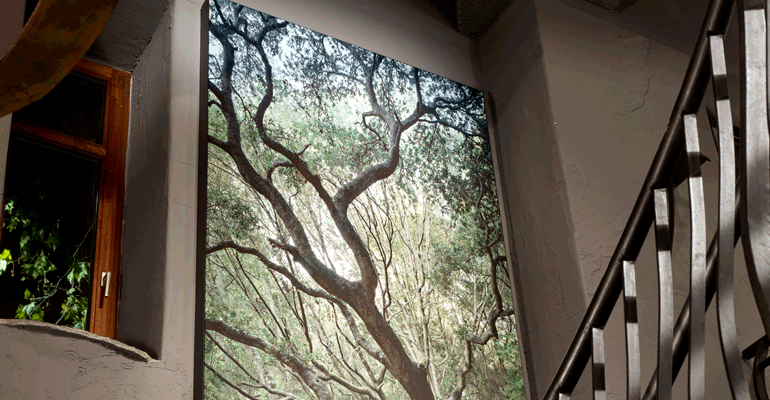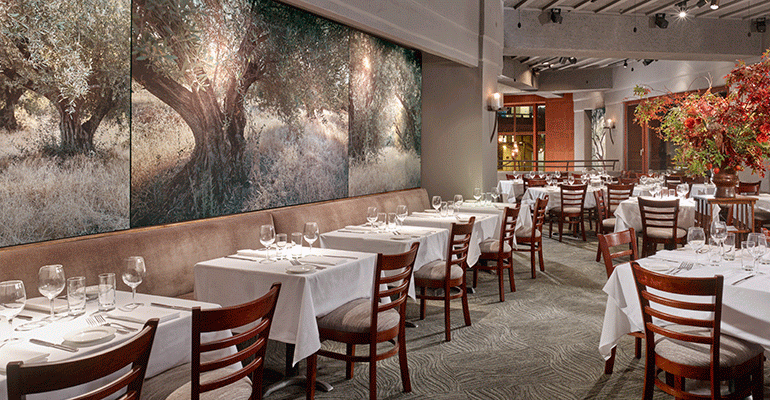Shouting across the table. Straining to hear your date over the din of a buzzing restaurant. Trying to block out the drunken laughter from the next table only inches away.
For many consumers, this is the reality of dining out. Yet the sound of a restaurant is often overlooked in design and many operators even encourage a certain level of noise in their venues, in part because it can convey a level of excitement and energy.
But as a growing number of consumers become more vocal in their complaints about noise levels, some operators in California are turning to new sound engineering technologies to let those guests know they’ve been heard.
“It’s like this major annoyance that you don’t really register or know that it’s possible to fix. Once you start thinking about this, you become super aware of the effect it’s having on the customers,” said Bob Klein, owner and founder of Oliveto Restaurant & Café. “It’s hard to hear and everyone is leaning forward to have a conversation; you get tired and it takes energy and you miss things in the conversation. You want to be with someone and have a nice meal but you’re operating at a deficit from the start.”

Klein at Oliveto, a nouvelle-Italian concept in Oakland, Calif., however, has found a solution.
The restaurant has reworked its dining room acoustics by tapping legendary sound wizards John and Helen Meyer, the visionaries behind Berkeley-based Meyer Sound Laboratories, a company known for the engineering of everything from massive performance venues to smaller university lecture halls. They even created the custom “wall of sound” developed for Grateful Dead concerts.
Klein knew the Meyers from the neighborhood and agreed to let them create and install a new sound system with sophisticated equipment during a renovation of the restaurant in 2014.
“I wanted to go all the way,” Klein said. “I wanted to give up every design issue in favor of acoustics.”
The way it works is complex, but basically, the Meyer Constellation system uses hidden microphones, speakers and digital-audio equipment, along with noise-absorbing panels.
The Meyers describe the sound system they’ve installed in Oliveto and several other restaurants in California as something that could be promoted as a feature of the restaurant, but could also go unnoticed — consciously, anyway.
“The comments we get from people who don’t know there’s this technology is that they tell the owners, ‘It’s really comfortable.’ And they keep coming back for that comfortable experience,” John Meyer said.
And it’s not just the customers who feel comfortable: A few servers at Oliveto have told Klein they’ve experienced less back pain from not having to lean in to hear customers at the tables.
At the core of the sound system is the need for balance, said Klein: Being able to hear conversations along with that background sound or buzz that says “busy, profitable restaurant” to owners and “cool, happening place to be” to customers.
When the Meyers first began testing the new system at Oliveto, a first iteration of very thick noise-absorbing walls made things weirdly quiet, Klein said.
“The room felt dead. When there’s that much less buzz, you lose privacy. You’re not guarded from hearing the entire conversation at the next table — so you need the buzz,” Klein said.
In fact, that buzz factor is an obstacle to getting many restaurant owners to consider a system like this, said John Meyer.
“The biggest problem that people have, is that they think the noisy environment adds to the experience of the restaurant. But we can make it still like a restaurant, but better,” Meyer said.
At Oliveto, for example, guests can converse comfortably at six- or eight-top tables, and there’s still a sense of being in a busy, exciting place.
Meyer systems are known in the classical music world for being customizable in terms of features like reverberation, with the ability to make an ordinary room sound like a cathedral, for example.
Klein has been able to take advantage of that control at the restaurant by hosting concerts, panel discussions and charity events.
With a system controlled by an iPad, “I can hit a button and the restaurant turns into a cathedral,” said Klein. “A famous acapella group of musicians came in here, looked around and said, ‘Where am I?’”
The startup costs aren’t insignificant, said Klein. But with the amount of money restaurateurs spend on creating a high-end space — tiles, millwork, fixtures, etc. — Klein said he doesn’t see the expense as ridiculous.
“If you’re a New York restaurant, you’re going to put $7,000 worth of millwork in … instead, you could spend the same amount and let people have a conversation,” Klein said.
The Meyers’ system is currently in five other San Francisco Bay-area restaurants, including Bellota, Cala and The Battery in San Francisco; and Donato and Co. and Comal in Berkeley.
Helen Meyer said there’s a new restaurant project in the works in Southern California, but declined to reveal the location.
The level of noise in any dining room is a feature restaurant operators should think about promoting as part of the overall customer experience, she added.
“I would like to think that restaurant owners, when they start planning a restaurant and automatically think about spending money on sound as an important expense item,” Helen Meyer said. “I think they could definitely call it out as a feature of their restaurant. Why not? Reviewers definitely call it out if a restaurant is too noisy.”
Contact Tara Fitzpatrick at [email protected]
CORRECTION, Feb. 2, 2018: The number of additional restaurants in Meyers' system has been corrected.





